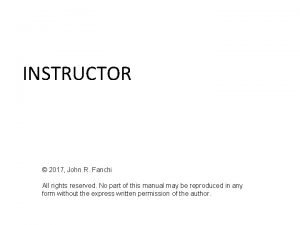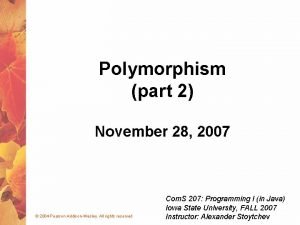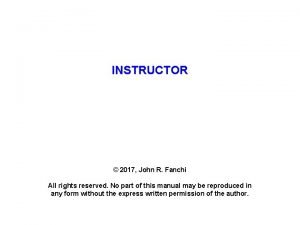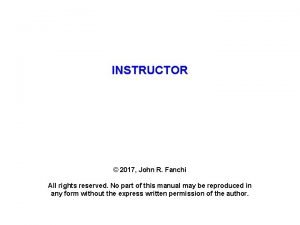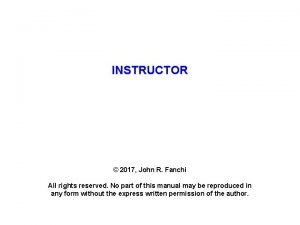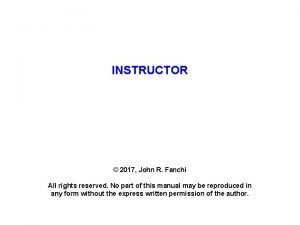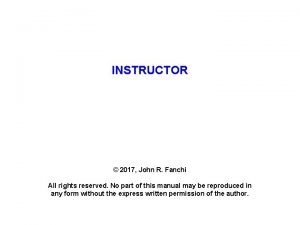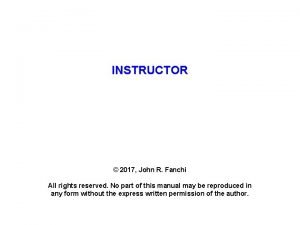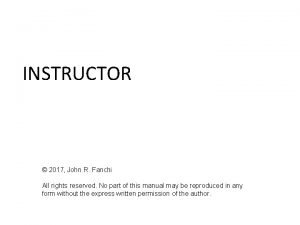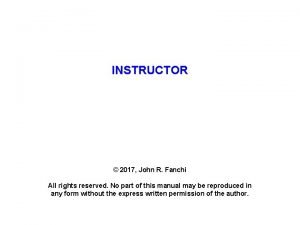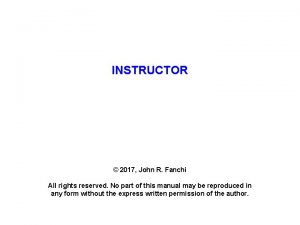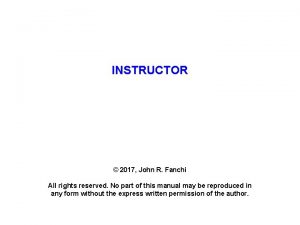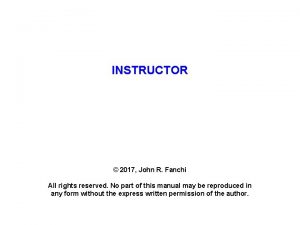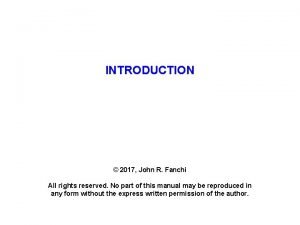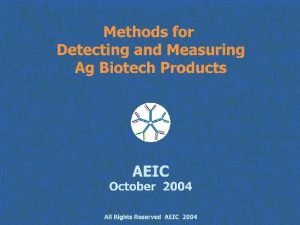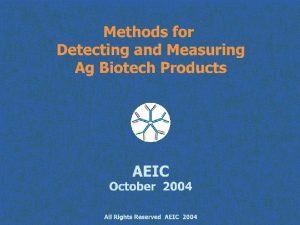INSTRUCTOR 2017 John R Fanchi All rights reserved



























- Slides: 27

INSTRUCTOR © 2017, John R. Fanchi All rights reserved. No part of this manual may be reproduced in any form without the express written permission of the author.

To the Instructor The set of files here are designed to help you prepare lectures for your own course using the text Introduction to Petroleum Engineering, J. R. Fanchi and R. L. Christiansen (Wiley, 2017) File format is kept simple so that you can customize the files with relative ease using your own style. You will need to supplement the files to complete the presentation topics.

DRILLING PROCESS © 2017, John R. Fanchi All rights reserved. No part of this manual may be reproduced in any form without the express written permission of the author.

Outline Ø Drilling Process Ø Well Types Ø Well Spacing

DRILLING PROCESS

Geologists/Engineers Propose Well Ø Assemble geologic maps & reservoir engineering data Ø Gather offset (nearby) well data Ø Mud records, bit records, casing programs, directional info, well logs, etc. Ø Ø Identify well site and target formations Evaluate economics Identify market Prepare Authorization for Expenditure (AFE)

Typical Cost of U. S. Onshore Wells vs. depth Average costs of oil and gas onshore wells drilled in the United States in 2004, from JAS (Joint Association Survey) data for listed depth intervals. Drilling Interval (ft) Avg Depth Avg Cost (ft) (Year 2004 US$ Million) 1, 250– 2, 499 2, 500– 3, 749 3, 750– 4, 999 5, 000– 7, 499 7, 500– 9, 999 10, 000– 12, 499 12, 500– 14, 999 15, 000– 17, 499 17, 500– 19, 999 1, 801 3, 165 4, 367 6, 275 8, 649 11, 074 13, 463 15, 886 18, 468 0. 304 0. 364 0. 416 0. 868 1. 975 3. 412 5. 527 7. 570 9. 414 http: //www 1. eere. energy. gov/geothermal/pdfs/egs_chapter_6. pdf

Seek AFE Approval Ø Management reviews AFE Ø Well authorized and funds allocated Ø Must match budget – amount and timing

Seek Stakeholder Approvals Ø Secure leases (if not secured already) Ø Main leases purchased with terms Ø Protection leases purchased Ø Deals made for farmouts (transfer of lease), trades, purchases Ø Identify partners Ø Partners sign Joint Operating Agreement (JOA) Ø Obtain permits Ø Work with government regulatory agencies

Select Vendors Ø Bids taken on major costs Ø Well site equipment (e. g. bulldozer) Ø Drilling equipment (e. g. drilling rig, pipe, mud, cement, bits) Ø Completion equipment (e. g. casing, cement) Ø Other (e. g. logging, tool rentals)

Drilling Contractor Ø Find Drilling Contractor Ø Drilling Contracts Vary by Risk Ø Turnkey Ø Fixed price for a specifically drilled & equipped well Ø All risk on drilling contractor Ø Footage Ø $/foot contract to TD Ø Risk shared by operator and contractor Ø Day rate Ø $/day to finish Ø Risk all on operator Ø Sign contract

Drilling Operations Personnel Ø Company Drilling Foreman (company or contract) Ø Company Drilling Engineer Ø Contractor Crew Ø Tool Pusher Ø Driller Ø Roughnecks (floorhands, derrick hand) Ø Service personnel (mud, bits, cement, casing, fishing, downhole tools, location/bulldozer, etc. )

Spud Meeting Ø Ø All parties involved with drilling meet Review drilling plan, timing & costs Discuss hazards & contingencies Specify spud date Ø Date to start drilling

Clear Location and Move in Rig Ø Lease & surface owner obligations must be met Ø Logistics Ø Clear location Ø Have equipment ready when needed Ø Rig moves in and rigs up (MIRU)

Drill Well Ø Ø Ø Adjust drilling plan from original plan if needed Daily drilling report from field Daily cost records maintained Routine inventory of mud, bits, pipe, etc. Evaluate well at target depth Ø Collect data for decisions – Logs, tests, etc. Ø Decisions: plug, deepen or complete

Wellbore

Well Completion Ø Rig down and move out (RDMO) Ø Typically use different rig for completion operations Ø Complete well Ø Ø Ø Finalize wellhead Move in service unit Clean out well Perforate and stimulate Test and submit completion reports

Begin Production Ø Build facilities (tank battery, separators, etc. ) Ø Select equipment based on expected Ø Pressure Ø Rates of oil, gas, and water Ø Begin production Ø Commence well flow Ø Monitor for optimum production rate

WELL TYPES

Exploration Ø Wildcat (aka controlled exploratory well) Ø Test a trap that has never produced (new field wildcat) Ø Test a new reservoir in a known field Ø Extend known limits of producing reservoir Ø Rank wildcat Ø Well drilled at least 2 miles (3 kms) from known production Ø Discovery well Ø The wildcat discovers new field

Development Wells Ø Wells for estimating field size Ø Appraisal well Ø Delineation well Ø Step out well Ø Development well Ø Well drilled in known extent of field Ø Infill well Ø Well drilled between producing wells in established field

WELL SPACING

Rule of Capture Ø Rule of Capture applies prior to 1930 Ø Based on Old English Game Law (hunting) Ø Establishes ownership of captured natural resources Ø e. g. groundwater, oil, gas, and game animals Ø In general, ownership of resource goes to the first person to "capture" the resource

Spacing Ø Spacing helps determine how fast we can produce oil and gas Ø How close can we space wells?

5280 ft Spacing 640 ac 5280 ft 1 sq mi = 640 ac 160 ac 2640 ft 1320 ft 40 ac 1320 ft

QUESTIONS?

SUPPLEMENT
 2017 all rights reserved
2017 all rights reserved All rights reserved example
All rights reserved example Copyright 2015 all rights reserved
Copyright 2015 all rights reserved All rights reserved sentence
All rights reserved sentence Freesound content licence
Freesound content licence Confidential all rights reserved
Confidential all rights reserved Sentinel value
Sentinel value Copyright © 2015 all rights reserved
Copyright © 2015 all rights reserved 2012 pearson education inc
2012 pearson education inc Microsoft corporation. all rights reserved.
Microsoft corporation. all rights reserved. Microsoft corporation. all rights reserved.
Microsoft corporation. all rights reserved. Microsoft corporation. all rights reserved
Microsoft corporation. all rights reserved Pearson education inc. all rights reserved
Pearson education inc. all rights reserved Dell all rights reserved copyright 2009
Dell all rights reserved copyright 2009 Warning all rights reserved
Warning all rights reserved Siprop
Siprop All rights reserved formula
All rights reserved formula Warning all rights reserved
Warning all rights reserved Confidential all rights reserved
Confidential all rights reserved Microsoft corporation. all rights reserved
Microsoft corporation. all rights reserved 2010 pearson education inc
2010 pearson education inc Copyright © 2018 all rights reserved
Copyright © 2018 all rights reserved Copyright 2010 pearson education inc
Copyright 2010 pearson education inc 2010 pearson education inc
2010 pearson education inc Confidential all rights reserved
Confidential all rights reserved Confidential all rights reserved
Confidential all rights reserved R rights reserved
R rights reserved Rights reserved
Rights reserved


























